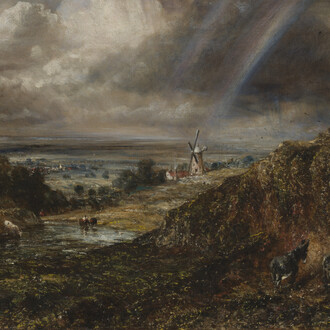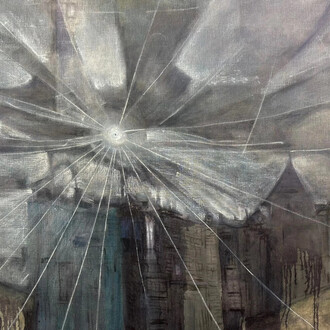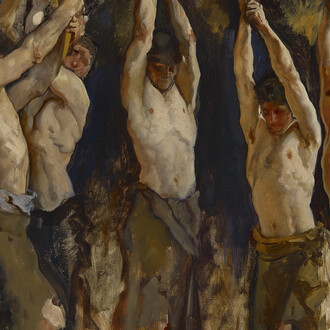Following the Grenfell Tower tragedy, attention has focused on the social and cultural needs of the community of North Kensington. Not four months after so many lives were lost or destroyed by loss, a dynamic, inclusive new arts venue bursts onto the scene, The Playground Theatre, formerly the North Ken bus depot, is being transformed into a burgeoning arts, community centre and café/bar.
The inaugural theatrical production which opens on November 1st is “Picasso”, featuring Peter Tate in the eponymous role, and helmed by award-winning opera and theatre director Michael Hunt (Aida, Madame Butterfly, ENO). The production is designed by Klara Zieglerova (Sister Act, Jersey Boys, Broadway and West End) and features members of the wide variety of talent from within the local community in the supporting cast. The play takes a coruscating look at the many loves of the artist, seen through the background of his dedication to his art.
Anthony Biggs, co-artistic director, and recently director of the Jermyn Street theatre ex- plains: “The Playground Theatre’s mission is to work with both established and emerging artists in the UK and internationally. The ethos is one of crossfertilization between different forms and different cultures with the aim of creating work that is bold and imaginative, whilst fully engaging the rich diversity of the community of which it is part”.
In keeping with this collaborative ideology, The Playground Theatre is delighted to introduce Portraits by the emerging Bulgarian-born painter Nelly Dimitranova. Opening in the space on November 13th, the exhibition draws on the essence of Picasso, Dimitranova and the play itself. Local curator Vicky Caplin explains: “My ethos is to match artists together with intimate and related spaces, most recently “Haunted Beauty”, in the Dissenters’ Chapel, Kensal Green Cemetery. The Portraits exhibition is designed very much with the “Picasso” production in mind”.
Introduced to Picasso’s work by her father, an acclaimed artist from Sofia, Dimitranova will present a series of new works, focusing on the conversation between the spiritual and personal and represented by a mixture of imagined and real portraits.
Dimitranova’s practice combines a lifetime’s devotion to the history of painting with the desire to present on canvas those human qualities that are invisible to the human eye. She paints women both from her immediate surroundings and iconic works of art. Her portraits begin as sketches: the artist uses minimal colours, inspired by Picasso’s palette, to create a form that she will later return to. Over time she will add to the painting from her own memory, erasing the very image she started with, all the while paying close attention to the brushwork to create a surface of delicate marks and blemishes.
Dimitranova was born into the family of a painter and a medical translator in Sofia, Bulgaria, At the age of thirteen was accepted to study at the Art School in Sofia where she received intensive training in painting and drawing, and from there she progressed to the Sofia Academy of Fine Arts. In 1991 she came to London to study at the Royal College of Art, supported by the Bulgarian Embassy and a grant from the George Soros Foundation. She now lives and works in London and has exhibited at the Royal Academy, the Royal College of Art, the gallery at Pentagram Design and the Conings by Gallery. In 2015 Dimitranova had a solo show at the House of St Barnabas and in the same year was the artist in residence for Red magazine.
Dimitranova’s portraits inevitably deal with loss and longing seen through a deeply personal and highly feminine perspective. Her admiration for Picasso is evident but as the play shows the women in his life had to battle against his compulsion to create, and to survive as artists, some had to escape him. “Absolutely women must work harder than men to reach the same level in the art world”, Dimitranova attests. Picasso, who loved so many women, contrasts with Dimitranova’s strongly feminine views, yet the play and the exhibition have themes in common. They both psychologically expose the women they paint, Picasso coming from a place of potent sexuality, Dimitranova from a place of gentle sensuality.
As she explains, “What I have found really interesting is that sometimes when I lose some- thing, the mere absence of it triggers an emotional reaction. Once we’re on the verge of losing something, the actual image becomes palpable in our mind.” Through this process of adding and taking away, concealing and revealing, Dimitranova blurs the lines between portraiture, abstraction of form and self-portraiture. The careful mark-making transforms the surface into flesh, the canvas into one body. She describes this method as one guided by intuition: “I’m just trying to find the language to express what it feels like to be with another person, to capture our ghosts, that is, the energy that emanates from that interaction”. Dimitranova is ultimately curious about the intimate psychic space between artist and model, object and subject, the observed and the observer, the human shenanigans of building up trust and friendship.
What is our emotional heritage? How are we changed by others? What do we pass on to the people around us? These are the questions that arise from the Portraits exhibition and will come into full fruition at The Playground Theatre, an arts centre whose very existence represents hope in an area grappling with loss.












